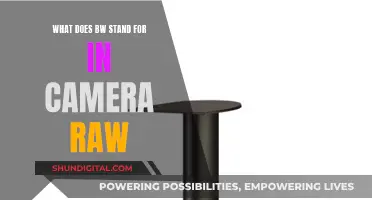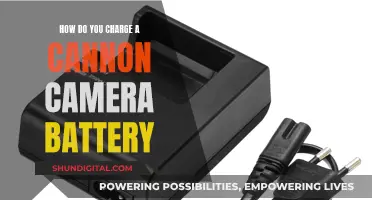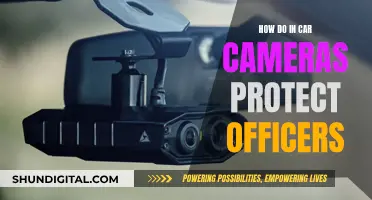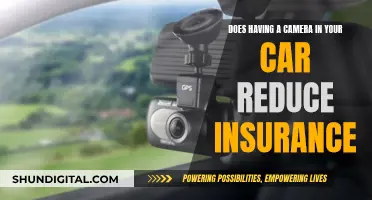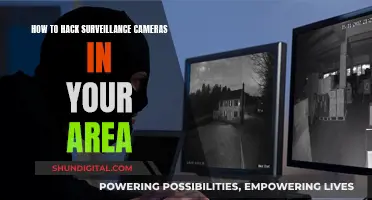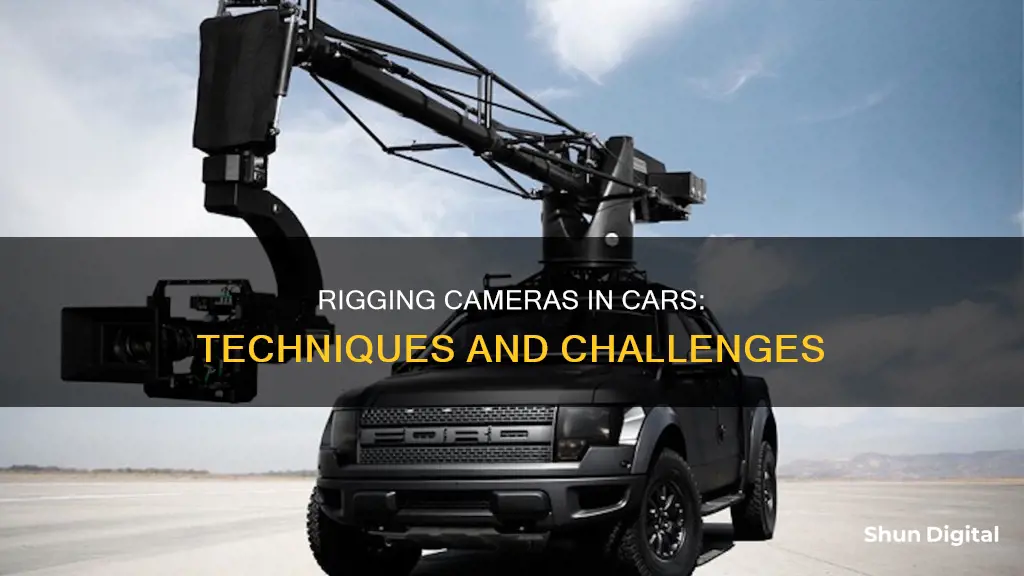
Rigging a camera in a car is a complex process that requires careful planning and execution to ensure the safety of both the crew and equipment. There are various methods for mounting a camera inside or outside a vehicle, each with its own advantages and limitations. The most common types of car mounts are the hostess tray and the hood mount, which can be attached using suction cups, magnets, or ratchet straps. Other options include using a tow bar to tow the vehicle, or a process trailer with a dedicated driver. Safety is paramount when rigging a camera in a car, as the camera can become a dangerous projectile in the event of an accident. It is also important to coordinate with local law enforcement to control the streets during filming.
| Characteristics | Values |
|---|---|
| Types of camera rigs | Handheld camera rig, tripod, pedestal, film crane/camera jib, overhead camera mount, camera dolly and slider rig, Steadicam rig, gimbal, Snorricam, vehicle and car camera mount, drone |
| Mounting options | Suction cups, magnetic mounts, hostess tray, hood mount |
| Safety considerations | Check local laws and requirements, don't obstruct the driver's view, use safety lines/tethers, ensure proper weight distribution, use ratchet straps, avoid operating camera on passenger seat |
| Time considerations | Rigging takes several hours to half a day, plan ahead, allow for sufficient time during production |
What You'll Learn

Suction cups and magnetic mounts
There are several types of suction cups available for purchase, including A-Cups, B-Cups, and C-Cups. A-Cups are the most general-purpose and cost-effective option, offering superb holding power. B-Cups have more holding power in a straight pull and less flex overall than A-Cups, but they are also more easily removed. C-Cups are the most heavy-duty option, featuring a vacuum pump mechanism and a visual safety indicator.
When using suction cups, it is important to clean the surface of the car thoroughly before attaching the cup. It may also be necessary to wet the suction cup to provide the strongest grip. Even with these precautions, suction cups can sometimes pop off, so it is recommended to also use ratchet straps to ensure the camera is firmly pressed against the car.
Both suction cups and magnetic mounts can be used to create various types of camera rigs, such as hood mounts, hostess trays, and side mounts. It is important to consider the weight of the camera and the stability of the rig when choosing a mounting option. Additionally, it is crucial to take safety precautions when rigging a camera to a car, such as using a secondary form of safety mounting or tethering and ensuring that the driver's view is not obstructed.
Vive Cameras: Battery or Plug-in Power?
You may want to see also

Hostess tray rigs
However, one drawback of this method is that it increases the width of the car, which can be problematic on narrow roads. It is important to work with a safety team to ensure the road is properly locked down, providing ample room for the driver to manoeuvre without the tray clipping something.
The Proaim Smart Side Camera Car Mount Hostess Tray Kit is an example of a product designed for this purpose. It is made of durable, high-grade aluminium and can support a camera setup weighing up to 22.6 kg/50 lb. It features a 14 x 14" aluminium cheese plate with a Mitchell mount for firm mounting and smooth shots. The setup can also be affixed upside down to capture low-to-the-ground shots.
The Ultimate Camera Companion: DE-A93 Battery Charger
You may want to see also

Hood mounts
A hood mount kit typically includes leg supports, rails, and a camera mount. The adjustable leg supports can be used to raise the camera to the desired height. The rails come in different lengths to accommodate different vehicles and mounting locations. The mounting plate can be customised to accommodate a tripod or gimbal, or to directly mount the camera. The plate can also hold other hardware, such as lighting or vibration isolation equipment.
When setting up a hood mount, it is important to hire an experienced grip to ensure the safety of the crew, equipment, and vehicle. It is also important to check local laws and requirements, as placing objects on the hood of a car that obstruct the driver's view may be illegal in some jurisdictions.
To set up a hood mount, start by cleaning the hood of the car. Use a suction cup or magnetic mount to attach the camera to the hood, and then "safety" the camera by attaching additional ropes, ties, or cables to the camera as a backup in case the mounting system fails. Ratchet straps can be used to provide extra stability. It is also recommended to tape off the focus and iris, as vibrations from the car can alter their settings.
Some things to keep in mind when using a hood mount:
- The setup process can take several hours, so it is recommended to do it ahead of time if possible.
- Always work in coordination with local law enforcement to control the street and ensure safety.
- A tow bar or trailer is necessary when using a hood mount, as the driver should not operate the vehicle with an obstructed view.
- Be aware of the weight of the camera and equipment, as it can affect the handling of the car.
- Multiple ratchet straps should be used to secure the rig thoroughly.
- Suction cups should be used with caution, as they can pop off if not properly attached. It is recommended to also use a ratchet strap to ensure the suction cup is firmly pressed against the car.
Apple Computers: Why No Camera?
You may want to see also

Safety precautions
Safety should be the top priority when rigging a camera in a car. Here are some essential safety precautions to follow:
- Plan and allow ample time for rigging: Rigging a camera in a car is a complex and time-consuming task. Ensure you allocate sufficient time to set up the rig safely and securely.
- Understand local laws and regulations: When rigging a camera on the outside of a moving vehicle, familiarize yourself with the local laws and requirements, especially when using public roads.
- Engage an expert: Collaborate with a grip who has experience in rigging cameras to vehicles. Their expertise will be invaluable in ensuring a safe and secure setup.
- Ensure a clear field of view for the driver: It is crucial to avoid obstructing the driver's view with the camera rig. Always prioritize the driver's visibility to maintain safety on the road.
- Secure all equipment: Use extra ropes, ties, or cables as backup in case the primary attachment method fails. This includes securing any loose lines to prevent them from becoming hazards.
- Protect the vehicle: Be cautious as cars are not designed to be camera-friendly. There is always a risk of cosmetic damage when mounting equipment on a vehicle.
- Use safety lines: Implement safety lines or tethers for both the camera and the mounting device. This will catch the gear in case of failure, reducing the risk of damage or injury.
- Avoid operating the camera inside the vehicle: Do not physically operate the camera while it is mounted inside a moving vehicle, especially on the passenger seat. In the event of an airbag deployment, this could result in serious injury or death.
- Work with law enforcement: For maximum safety, coordinate with local law enforcement to control the street or road you are filming on. This ensures a safe environment for your crew and bystanders.
- Be cautious with suction cups: Suction cups require a thorough cleaning of the mounting surface and proper wetting as per manufacturer instructions. Additionally, consider using ratchet straps as a backup to ensure the setup remains firmly pressed against the car.
- Be mindful of projectiles: In the event of an accident, unsecured cameras and equipment can become dangerous projectiles. Always secure equipment properly and consider using a follow vehicle for personnel and equipment.
Traffic Cameras in California: Tickets or Not?
You may want to see also

Dolly and slider rigs
One of the simplest ways to use a car as a dolly is to film through the windows, capturing wide establishing shots or voyeuristic atmosphere shots. This technique is a great way to build scope and create movement in your film. You can also try filming out of the window, using a gimbal to capture high- and low-speed tracking shots of other vehicles.
If you're feeling more adventurous, you can try filming out of the back of your vehicle. By dangling your camera low out of the rear, you can capture beautiful slow dolly shots, nice push-ins, and even detailed slider moves. Just make sure you're always properly strapped in for safety. SUVs, trucks, and vans are ideal for this type of footage.
Another creative technique is to film from the side of your car with the sliding door open. This method works best with a vehicle that has a sliding door that locks open. This setup can capture fast-paced tracking shots of people, animals, or landscapes, adding a sense of dynamism to your film.
When it comes to equipment, there are a variety of camera dolly and slider systems available on the market. RigWheels, for example, offers scalable dolly and mounting products that can be customised to suit your production needs. Their Passport 2 Portable Camera Dolly Slider with Track is a popular choice for filmmakers. Other options include the GVM Wireless Carbon Fiber Motorized Camera Slider, which offers iOS/Android app control, and the Kessler Crane CineSlider, a heavy-duty sliding system with adjustable drag control and a friction brake.
Whether you're working with a simple setup or a complex rig, always prioritise safety and ensure that everyone involved understands the procedure. With creativity and careful planning, you can capture stunning footage using dolly and slider rigs in cars.
Surveillance Cameras in Massachusetts: What's the Law?
You may want to see also
Frequently asked questions
There are various types of car rigs available, each offering different shot selections, flexibility, and requirements from the actor. Some common types include hood mounts, hostess trays, side mounting, car-mounted jib arms, stabilizers, and full-blown process trailers.
Safety is of utmost priority when rigging a camera to a car. It is important to check local laws and requirements for using public roads and have a grip on board who is knowledgeable about rigging cameras to cars. Ensure that the driver's view is not obstructed, and always "safety your gear" by running extra ropes/ties/cables as a backup in case the primary attachment method fails.
Suction cup mounts and magnetic mounts are easy to set up and serve the same function. Magnetic mounts require a metal (iron or steel) surface, while suction cups need smooth, nonporous flat surfaces. Magnetic mounts may be preferred as suction cups can be affected by dirt or age. However, both types of mounts may cause cosmetic damage to the vehicle.
Rigging a camera to a car can be a time-consuming process. Even the simplest setups can take several hours, while more complex rigs may require half a day or more. It is recommended to prepare the rig ahead of time to avoid delays during production.
Shooting with a camera-rigged car requires coordination with local law enforcement to control the street and ensure safety. It is unsafe to shoot without their presence, as the camera can distract drivers and increase the risk of accidents. Additionally, having an actor perform while driving is unsafe, as their concentration may be divided.


